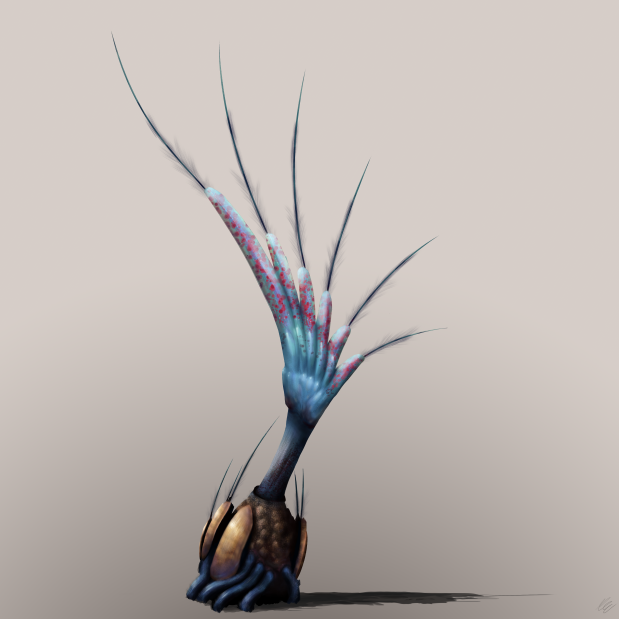
The Erimian thunder plant is a species of carnivorous plant native to the dry shrublands and waterways of its homeworld, Erimia. On average they are 5 meters tall and are composed of 4 main body sections: the root system, the bulb, the leaf, and finally the wire canopy.
First is the root system. The root system is analogous to those of Earth plants except for one key difference: they contain glands of stomach acids for dissolving rock. The reason for this is due to the fact that carbon dioxide is ridiculously low on Erimia; less than 10 parts per million. To survive, the thunder plant’s ancestors evolved to dissolve rock to release the CO2 within, leading to slow-growing lithotrophic forms. From their roots, they also absorb iron, a metal essential for their hunting strategies that we will get into later.
The second section is the bulb, a large water-retaining structure resembling potatoes’ tubers. With it, the plant can survive for decades without rain and for this reason, bulbs are a common food source for many desert animals. In more prominent species like the Eremian thunder plant, the bulb extends above ground, and early on is protected by a simple oxide shell. As the plant ages, the shell breaks apart, leaving only a few small brown segments and allowing for the growth of the side roots, roots that support the bulb and leaf aboveground.
Next, there is the leaf, a large, sail-like structure that contains many smaller sub-leaves or “fingers” to increase surface area. Unlike the leaves of conventional plants, the thunder plants’ singular leaf is a bright electric blue. This is due to the fact that plants on Erimia as a whole use anthocyanins instead of Earth’s green chlorophylls, giving their leaves a striking blue color. Another notable feature of the leaves is the multiple pink spots that appear on the plant’s leaf tips during the planet’s springs. These pink spots are called jamlets and are the closest thing Erimian life has produced to flowers. Jamlets are pockets of reproductive puss that contain both gametes and sweet nectar. Pollinators absorb both and fertilization occurs inside the pollinator’s digestive tract. The gametes fuse into a spore, and once released by the pollinator begin a new life outside, repeating the cycle.
Finally, we have the wire canopy, the tallest, and most noticeable section of the plant. Individual wires are around 2 meters in height and grow on the tips of the sub-leaves. These wires for the most part are made of iron and are remarkably lightweight for their composition. During frequent sandstorms that ravage the shrublands, the wires absorb static electricity from the sand and other debris, storing it in battery-like organs at the base of the wires. When potential prey passes by, highly sensitive electroreceptors that line the wires activate the batteries, releasing the stored electric charge. Usually, this activates around 3 to 4 batteries at a time, enough to kill most flying prey. Afterward, the prey falls, landing on the leaflets before being guided toward the tangled mess that is the side roots. Then digestion begins. The side roots, similar to their underground counterparts, release stomach acids alongside various other corrosive enzymes that slowly digest the prey from the outside. When the remaining slurry is broken down enough, digestive hyphae appear from the side roots, absorbing the remains. In less than a day, the only remains left are the inedible corroded skeletons that it couldn’t digest.
This entry was made by Tardigrade and RezonantVoid.